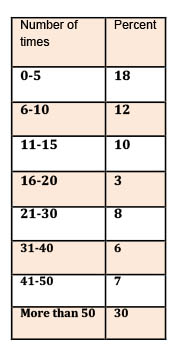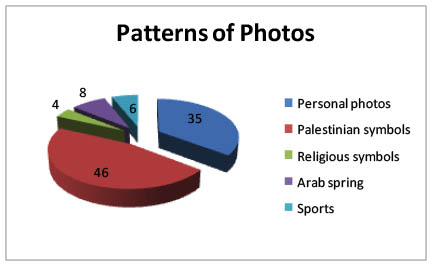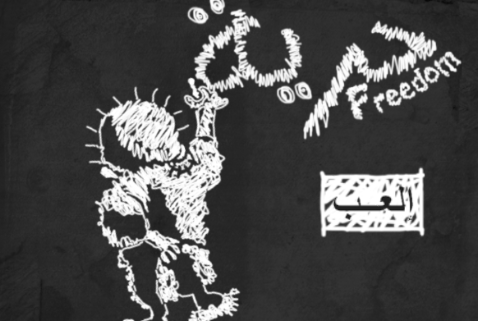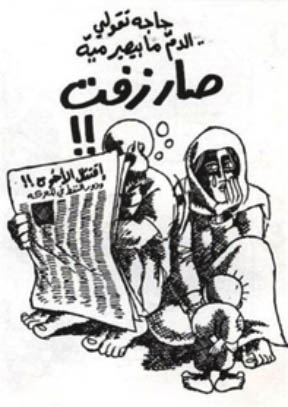I would like to think that we are not just the people seen or looked at in photographs: we are also looking at our observers….we too are scrutinizing, assessing, judging. We are more than someone’s object. We do more than stand passively in front of whoever…has wanted to look at us. -- Edward Said, After the Last Sky
Over the course of several decades in the Palestinian history, Palestinians have been the subject of thousands if not millions of photos, frequently taken by others: the UN, Israel or Arab States, and nongovernmental organizations. Some of these photos became what Edward Said described as” iconic” images in both Western and Arab mass media. In the 1950s, the “iconic” image was that of the helpless Palestinian refugee which was replaced in the 1980s by the “terrorist” motif. In subsequent years, stone-throwing Palestinian children, flag-waving, replaced this and flashing the victory signs which dominated the First and Second Intifada.
The advent of the Internet in the Arab region in 1990s and the introduction of web 2.0 technologies along with digital photography enabled Palestinians to present themselves for the first time in different political and social contexts. Nowadays, social platforms, particularly Facebook, are immensely popular amongst Palestinians, with more than 970,000 active users in the West Bank and Gaza Strip in 2012. The quick dissemination of images via mobile phones and other devices promotes pictures as the preferred idiom in the practices of Palestinian Facebook users and consequently communicating and circulating different sociopolitical realities, which was not possible before. Besides the typical personalized utility of the platform, it is also used to advocate for, arrange, and mobilize for political activities, such as planning demonstrations, amplify campaigns. Both the Israeli occupation and the Palestinian Authority often closely monitor these activities.
Research on how photos are used on social media websites affirms the significant effects of images on communication, identity, and reality. Most of the research demonstrates that the use of digital images is changing the way people express and communicate their understanding of reality and visual experience. This paper examines how one hundred Palestinian Facebook active users from Birzeit University present themselves via profile images and how they interpret their choices. The study is based on data collected from a survey published on a Facebook group called Ana badros i’lam fi Birzeit (“I study media in Birzeit”) in 2012. The focus of my study is the profile image because it is a single image that virtually and visually encapsulates the momentary self-representation of a user on Facebook. Strano asserts that profile pictures are “idealized images that represent social norms about desirable personal characteristics and socially accepted notions of family, gender, romantic relationships and parenthood.” He also argued that Facebook users are very conscious about what identity they project with the profile picture choice. In this study I suggest that the interpretations of one hundred profile images and reasons behind choices could indicate the identity formation of the participants and reflect on the current complexity of the Palestinian situation. In his book Palestinian Identity, Rashid Khalidi explained:
The Palestinian identity never has been defined solely by the conflict with Zionism and Israel has based itself on different elements, some of these elements are local, some religious, and some draw on other national narratives, all have been reshaped and reworked to fit constantly new narratives of identity.
The decoding of the one hundred profile images produced five categories to describe the patterns of used photos: Palestinian identity symbols, personal and family photos, Arab uprisings, sports, and religious photos. The paper elaborates on the majority of used photos (Palestinian identity symbols and personal and family photos), constituting eighty one percent of the participants whereas for example photos related to the Arab uprisings that made up eight percent were interestingly directly linked to the Palestinian cause and the rest of the categories were only mentioned. In the first category, Palestinian identity symbols, most of the participants chose a photo of the Mediterranean Sea coupled with photos of Palestinian political figures. The second category, personal and family photos, reflected the importance of group identity for the participants particularly in a family-oriented context with equal portrayals for both genders. However, the female participants of the study revealed a sense of restlessness prevalent among some Palestinian women regarding posting photos on Facebook.
Methodology
Birzeit University’s media department created the Facebook group Ana badros i’lam fi Birzeit (I study media in Birzeit) for its graduate students who constitute the group’s two hundred fifty five members. Some of those members were eager to voluntarily share the survey with their friends, family, and acquaintances. It is important to note that Birzeit University is considered by many Arab and Palestinian intellectuals as an academic icon of the Palestinian national movement and has played an important role in shaping political activism in many significant ways. The community closely follows Birzeit student council elections as their results often reflect the general Palestinian political mood due to students’ level of engagement and diversity. Moreover, the participants in this study come from different, cultural, and political backgrounds from the West Bank, some were graduates and young professionals, others were still perusing their degrees at the media department, but all were active internet users and were personally motivated as they distributed the survey themselves and sent results.
The survey consisted of background questions about the users–their age, gender, profession, and how frequently they change their profile pictures. It also included informative questions on the profile image itself, such as a detailed description of the photo and reasons behind choosing the image. The goal of these questions was to analyze the descriptions, interpretations, and personal meanings evoked by the choice images. Subsequently, descriptive categories of the common profile photos could be identified.
Demographically, the survey included four different generational categories: 1) Fifteen to twenty years of age (high school and university students) constituted twenty-two percent of participants; 2) Twenty-one to thirty years of age who can be identified as young professionals were the majority of this study representing with fifty-five percent of participants; 3) Thirty-one to forty years of age included seven percent and finally the last category of over forty-one which makes twelve percent of the participants.
Male users were forty-eight percent and females fifty-two percent for those surveyed. Comparatively, the official numbers of Facebook users in Palestine were estimated at fifty eight per cent male and forty two percent female users. This percentage is considered high comparing to other Arab countries.[1]
Facebook in the Palestinian Context
The politics of Facebook are confusing when it comes to Palestine. Facebook erased and deleted Palestinian groups calling for a “third Palestinian Intifada,” and deactivated the accounts of journalists and activists. For some time, Palestinians were unable to create page titles including the word “Palestinian” as they were blocked in Facebook’s automation process. Those acts were justified by Facebook’s policy of prohibiting any content believed to be “defamatory, infringing, abusive, inflammatory ... hateful, or racially, ethnically or otherwise objectionable.” In 2006, Facebook erased Palestine as a country of choice. Palestinians and supporters of Palestine were outraged and a petition titled “Against delisting Palestine from Facebook” was circulated by Ronald Habash and garnered at least sixteen thousand signatures. Facebook responded to the pressure and re-added Palestine to the list of countries in 2007. There was no press release to explain either action.[2]
Moreover, Facebook is used by both the Palestinian Authority and the Israeli occupying government as a tool to identify and condemn activists and oppositionists. Palestinian authorities prosecuted more than a dozen Palestinian journalists for statuses and photos posted on Facebook. A notable case is that of journalist Mamdouh Hamamreh who was sentenced to a year in a Palestinian prison after he was tagged in a photo that offended Mahmoud Abbas. The photo juxtaposed Abbas and a doppelganger playing the part of a collaborator with French colonial forces in an old Syrian television drama. After a while, the journalist was pardoned and released by Abbas himself. The Israeli government also uses Facebook to monitor online activities of Palestinians and often identify and blacklist them. In 2011, the Israeli government prevented European activists from boarding planes in Tel Aviv to join a “Welcome to Palestine” solidarity event. A blacklist of three hundred protestors’ names was compiled by the Israeli government to track activists on Facebook who communicated their travel plans online.
Despite the ambiguous policies of Facebook towards the Palestinian cause, Facebook users utilize the platform to arrange political activities, particularly in planning demonstrations against the Apartheid Wall in villages located in the north of the West Bank such as Budrus, Bil’in, and Ni’lin. The demonstrations’ invitations on Facebook were created by activists and sent to a wide network of supporters and journalists. Once the demonstrations take place, photos are shared and circulated, especially if the Israeli military becomes involved. Furthermore, numerous political campaigns and forums were launched on Facebook. For example the campaign of Palestinian prisoners (in April 2012 two thousand Palestinian detainees and prisoners went on hunger strike, one of them was Khader Adnan who refused food for sixty six consecutive days and attracted global attention of the situation of Palestinian prisoners). The campaign was presented with an illustration of a faceless blindfolded Palestinian prisoner, which became popular amongst Palestinian Facebook users and was adopted as a profile image for thousands of Palestinians. The picture of the faceless prisoner was designed by Palestinian artist Hafez Omar as a way to spread awareness of the harsh conditions facing Palestinian prisoners and inhumane Israeli detention procedures. Moreover, different variations of the image were also presented as profile images of hundreds of Palestinian Facebook users.
Dynamics of Self-Profiling
A previous study on Facebook users’ practices of profile images estimated that Facebook users change their profile images at least seven times a year, a percentage that corresponds well to the user practices in this study. Thirty percent of the participants acknowledged changing their profile image more than fifty times since they had opened Facebook account.

Number of times the Facebook users
changed their profile images
As for the reasons behind changing the profile images, forty-four percent of participants said that the political and social environment play a huge role in changing the profile image. Thirty-three percent of the participants considered the personal mood to be the main factor while some said the availability of more current photos. Only ten participants confessed that they only change their profile image when their friends and acquaintances ask them to and the rest did not clarify specific reasons. In order to understand the frequencies of different profile photos used by the participants, it is important to consider the political timeframe of the study.
In 2012 the West Bank witnessed a record number of violations committed by the Israeli occupation. These included demolished Palestinian homes in the West Bank and East Jerusalem, imposed severe restrictions on Palestinian freedom of movement, continued building of illegal settlements, all in addition to killing five Palestinian protestors and detaining civilians including children. Human Rights Watch reported in September 2012 the detention of 164 Palestinian children under eighteen years old, two hundred seventy two Palestinians in administrative detention without charge. The Palestinian Authority’s security services had also arbitrarily detained arbitrarily hundreds of “Hamas supporters”
Decoding the profile images
The survey showed that forty-six percent of participants utilized images that represent Palestinian national symbols. Personal photos constituted thirty-five percent of the respondents. The remaining nineteen profile images can be divided into three categories—Arab uprisings, religious content, and sports (see the chart below).

Palestinian Symbols and Icons
The category of the Palestinian symbols constituted the majority of the survey participants. Forty-six percent of the participants identified themselves with a photo related to Palestine. Ortner (1973) explained that national symbols are created to denote shared experiences among members of the group, essential for the group’s cultural and national survival. Those photos were different from the traditional Palestinian icons: for example, there were hardly any photos for Palestinian political figures such as the Palestinian president Mahmmoud Abbas. The exception to detained politician Marwan Bargouthi who was mainly identified as a Palestinian prisoner more so than a politician. Eighteen percent of the photos were dedicated to the Mediterranean Sea in historical Palestine (1948), fifteen percent to Palestinian prisoners, eight percent of Naji Al-Ali’s caricature character Handala, three percent to some variation of the Palestinian map and finally two percent expressing solidarity with Gaza (and text graphics of Gaza).
The issue of space is negotiated daily, in both the West Bank and Gaza strip particularly after the building of the Apartheid Wall, and with the gradual and ceaseless fragmentation of Palestine into isolated cities and towns, surrounded by Israeli settlements and hundreds of checkpoints. As van Dijk describes photography as an extension of memory, the largest proportion of participants in this category use profile images of themselves with spatial landscape photographs, namely the Mediterranean Sea in historical Palestine. The choice reflects the nostalgic sentiments of the constantly vanishing geography on the map of Palestine, as the Mediterranean Sea is located on the Israeli side of the Apartheid wall, making it impossible to visit without complicated procedures of permits yet it is deeply rooted in the collective memory of most Palestinians. Hence, Palestinian Facebook users relied on photographs of the sea to collectively “remember” the past. Two respondents explained further their choices:
I chose the sea in Akka because I cannot go there, because I miss it and I want to share this with the rest of the world
Another participant explained:
My image is my photo near the sea in Haifa; I chose this photo because I want to remind myself that it still exists. I wish I could go there more often without all the permits and complicated procedures
The map of historical Palestine is also linked to negotiating collective memory about Palestinian landscapes where constant physical barriers are nonexistent on Facebook. One participant elaborated:
My photo is a map of historical Palestine. I posted this photo not because of the traditional reasons we do as Palestinians, but because Palestine is becoming smaller everyday and I want to remind myself and the world that this is our real map
Fifteen participants chose photos related to Palestinian prisoners. The issue of the Palestinian prisoners is presented in the daily life. According to MIFTAH, twenty percent of the Palestinian population in the West Bank and Gaza Strip has been detained at least once since 1967. Along with the fact that the conditions of the prisons and treatment of Palestinian detainees and prisoners is dreadful, violating numerous international as well as Israeli laws, renders the Palestinian prisoner issue a near-sacred one that is imbued with emotionally-loaded symbolism and one of ardent solidarity. One participant described the reasoning behind this choice:
My profile image is a picture of me and my brother. He is sentenced to thirty years in Israeli prison for fighting for his rights and for freedom since 2002. I chose it to raise awareness about Palestinian political prisoners and their plight. And because the picture shows his human side and his love to his family also it shows the harshness of occupation that separates families
Another participant explained:
My profile image is a photo of Marwan Bargouthi with handcuffs on his hands but doing the victory sign. I chose this photo because of what it represents for the Palestinian cause. I think that the prisoners issue is the reason why the Palestinian cause is still alive. They link our past with the present and the future
Palestinian national symbols do not have equal importance or longevity. Some symbols disappear and others persevere, one example is Handala, the cartoon character based on a Palestinian refugee child created by the late political caricaturist Naji Al-Ali in 1975. Eight participants posted different cartoons of Handala as their profile image, one respondent described his choice:
My photo is Handala writing hurria (freedom), I chose this photo because I think that there is no other symbol that can represent our struggle for justice and freedom

Widely circulated image of Handala writing the word "freedom" was a common profile image.
One participant explained his image:
My photo is a cartoon of Naji Al Ali for a husband and a wife. The wife is telling him “blood won’t become like water,” and he is saying “it became asphalt!!” I think this cartoon is a very accurate demonstration of what is happening in the Arab world, although the cartoon was drawn to present Palestinians, I think nowadays it is very true too for the Arab people (below)

[Naji Al Ali`s cartoon]
The Personal in the Profile
The second category is personal photos representing thirty-five percent of profile images. Most of these photos, twenty-five percent, were photos of family and friends whereas only ten were self-portraits. This observation suggests that group identity is important for the respondents in this study.
Scholars found that it is common for Facebook users to construct “group oriented identities” by posing for pictures with others. In the same way, Palestinian users portrayed themselves mostly in family contexts. Both genders were equally likely to present themselves in family-oriented circumstances, but the way users interpreted their choices appeared to differ by gender. It is interesting to note that women were more likely to post photos with their significant other, whereas men presented photos of themselves with children or other family members. For instance, one female respondent reported that her photo is “a picture of my daughter, my husband and me at her birthday. I chose this photo because we look like a very happy family”
Another woman who had a photo of her fiancé said she chose it because she wanted to show him that he represents her “even on Facebook.” Male participants on the other hand often posed with their children because it made them look like good fathers. In one case, a male who posted a profile photo of his himself and his fiancée hand-in-hand following an exchange of rings demonstrated his non-single status and publicized his commitment to her.
In other examples, men described their motivation for posting the photographs in terms of directly impacting their relationship with their significant other rather than projecting as an identity as in the women’s responses. Also the self-portraits were mainly posted by men, in an official context and reported that they chose to post these because they made them feel “handsome” or “professional.”
Conclusion
Most of the participants of the survey resort to Facebook as a default page for news and entertainment. They spend many hours daily choosing what photos to post and what to communicate to their Facebook friends, carefully crafting an online identity. The findings of this survey showed how images were used to construct, imagine, assert, and reinforce Palestinian identity as well as the negotiate personal and socially-accepted norms of gender, family, and parenthood.
The majority of Palestinian Facebook users at the time of the survey had chosen images of the sea to stimulate Palestinian collective memory as well as negotiate vanishing space in Palestine using the historical map of Palestine. The Palestinian prisoners during the time of the study were elevated to a near-sacred symbol and Handala remains a salient perennial symbol of Palestinian consciousness and an emblem of loss, bitterness, and anguish. Personal photos revealed the contrast and pressure between two overarching tendencies—an individualist one versus a collectivist one within Palestinian society. Most Facebook users projected themselves in a group family oriented context, despite some of the gender difference in this regard.
While most images often go unnoticed, this study showed that, conversely, users spend disproportionately long periods of valuable time pondering and choosing what to post for their profile images. Among the study’s participants, the profile image is seen as a significant signifier of identification, expression, and representation. As a preliminary explorative glimpse into these patterns of online self-reification, it is evident that this is very rich ground for further research and merits more in-depth study.
------------------------------------
Notes
[1] According to Mourtada and Salem (2012), Arab women’s use of social media is low compared to men, as well as in comparison to the global female usage average (for example, women make up about half of Facebook users globally, while they make up only a third of users in the Arab region. Mourtada, Racha and Fadi Salem, "Social Media in the Arab World: the Impact on Youth, Women and Social Change." Culture and Society 1 (2012): 269-274.
[2] Fatafta, Mahmoud, "The relation between freedom of speech and new media: Facebook as a case (Arabic)," MADA 1 (2011): 4-224.